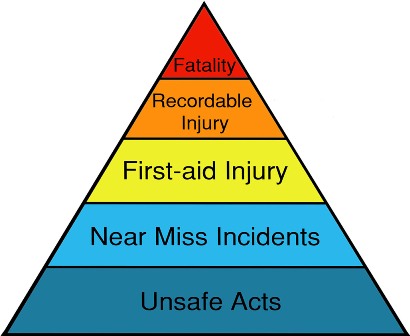A few days ago I was updating one of the lectures I do for my Experimental Physics course. I was putting in a bit more about safety and managing hazards, which are things that are associated with doing experiments for real. When I was a student, we didn't learn anything about this – my first introduction to the ideas behind hazard management came only when I joined an employer. Before then, I simply hadn't thought about the issues involved.
One of the things that gets banded around Health and Safety discussions is Heinrich's pyramid, dating back to 1931. The basic idea of this is that accidents don't just happen out of the blue. For every fatal accident there are several non-fatal but major accidents, for every major accident there's several minor accidents, and for every minor accident there's a whole heap of incidents (things that could have been accidents if circumstances had been different). The implication is then that by addressing the minor things that crop up frequently, we make the workplace a safer place. I've seen various versions of the pyramid on-line, but here's one:

Diagram taken from http://www.enerpipeinc.com/HowWeDoIt/Pages/safety.aspx
That all seems to make some sense. However, searching around for a good picture to include in my lecture notes, I came across this article by Fred Manuele:
http://www.asse.org/professionalsafety/pastissues/056/10/052_061_f2manuele_1011z.pdf
It calls into question the whole basis of this pyramid and its implications for health and safety in the workplace. Specifically, Manuele reports that:
1. No-one can trace Heinrich's original data
2. If it exists, then the extent to which 1920's and 30's data applies in today's workplace is dubious.
3. That the pyramid idea is counter-productive to ensuring a safe working environment since it over-emphasizes the importance of minor non-compliance issus (not wearing one's lab coat) and focuses attention away from major, systemic failings in senior managment and even government regulators and legislators whence the really big events tend to come. [Think Pike River, where MBIE's own investigation points the finger at itself (in the form of its predecessor, the Ministry of Economic Development) for carrying out its regulatory function in a 'light-handed and perfunctory way'.]
There's some lovely statistics included on what a focus on reducing small incidents actually does. Here's some US figures on the reduction in accdient-related insurance claims between 1997 and 2003 (F. Manuele, “State of the Line,” by National Council on Compensation Insurance, 2005, Boca Raton, FL):
Less than $2000: Down 37%
$2000 – $10000: Down 23%
$10k – $50k: Down 11%
above $50k: Down 7%
See the issue here? Focusing attention on small incidents and small accidents does wonders for reducing small incidents and small accidents, but very little on reducing the big accidents. That's because, as Manuele describes, they have different underlying causes.
The paper's worth a read, and cuts at what I've been taught over several years about health and safety. One notable feature is that it actually draws from hard data, rather than myth, which is how Manuele labels Heinrich's work.
And the consequence for my experimental physics students? I shan't be including that pyramid in their lectures.